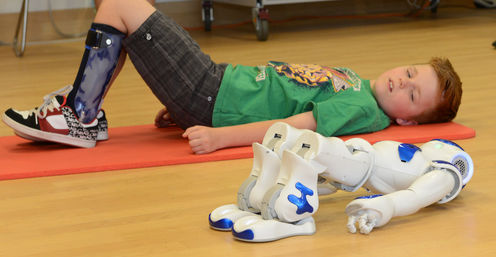
Anyone who has undergone any intensive physical rehabilitation knows the frustration, boredom and discomfort that comes with repeated exercises over days, weeks and even months. For young children and their families, rehabilitation is often a traumatic and emotional time.
Physiotherapists and doctors may be highly skilled in the art of child motivation and distraction, but such motivation costs precious time and resources. And despite their best efforts, not all sessions achieve positive results.
The advent of social robots is giving rise to new possibilities in paediatric health care.
So what does it take to deploy a robot as a clinic-ready therapeutic aid for diverse patients? What benefits does this technology offer? And how will patients and health professionals engage with robots in their daily practice?
We have been exploring these questions by using the highly engaging humanoid robot NAO as a therapeutic aid for paediatric rehabilitation.
Robot helper
At just 58cm tall and equipped with a range of sensors, NAO is an ideal candidate for engaging and motivating children during rehabilitation.
 Watch Video on YouTube
Watch Video on YouTubeThe robot’s life-like gestures, such as gentle swaying, subtle responses to touch and sound, and watchful head movements, give it an unquestionably authentic presence that harnesses the attention of children, and adults alike.
Rehabilitation requires more than a child’s attention, it requires ongoing compliance with therapist instructions and the motivation to persevere. We have programmed NAO for three new roles to meet the needs of a therapy assistant: the motivator; the demonstrator; and the instructor.
As motivator, NAO provides both verbal encouragement and enticements to children through the promise of rewards such as dances, music and jokes. NAO might say to a child practising exercises:
When we’re done, I will show you my awesome dance moves!
It can provide more personalised phrases based on the patient’s interests:
Slam dunk Derek!
Demonstration is NAO’s most practical function. In this role, NAO introduces and describes each exercise before performing the action in front of the child. NAO then invites the child to perform a set with it.
 Watch Video on YouTube
Watch Video on YouTubeThe third role has NAO is as an instructor, leading the child through a series of activities in the form of a game. NAO attentively tracks movement, provides feedback on technique and reacts to specific milestones with gestures and words of encouragement.
While still in development, this role has been strikingly effective with patients so far.
NAO’s instructions and motivational phrases have been programmed to largely emulate those provided by physiotherapists, yet, its words are clearly treated differently by children. NAO’s persona as a childlike peer rather than instructing adult and its novelty factor contribute to its success so far.
Beyond the capacity of any current speaking toy, NAO quickly builds a rapport with each child through the careful design and configuration of personalised interactive behaviours.
Rapport with patients should improve as more advanced machine learning, natural language processing and computer vision algorithms build up NAO’s situation awareness.
Towards a clinical trial
Over the past 12 months, NAO has worked with more than 30 different individual patients at the Royal Children’s Hospital in Melbourne.
Physiotherapists have generally noted improvements in both patient compliance and mood when NAO is present compared to sessions when it is not. A formal clinical study, examining performance over a prolonged period is needed to establish the true therapeutic benefits of this technology.
Later this year, we hope to conduct a trial with children with cerebral palsy undergoing rehabilitation following gait corrective surgery. The aim will be to use NAO as a therapeutic aid in post-surgery inpatient rehabilitation programs, and through this, gain a more accurate measure of NAO’s effectiveness as a therapeutic device.
A replacement for physiotherapists?
Although the results so far with NAO are impressive, there is the question of whether such socially assistive robots could eventually replace physiotherapists.
We think that’s unlikely. In fact, our observations suggest NAO’s benefits are greatest when working in a therapist-robot team.
We aim for NAO to perform certain tasks on behalf of a therapist, who often cannot attend every rehabilitation session. Using a simple interface based on existing clinical practise, physiotherapists will configure NAO to lead independent sessions of rehabilitation.
NAO will then provide assistance to other attending adults, such as parents and nursing staff, as the child works through rehabilitation exercises on ward, or at home.
Beyond paediatrics?
The work so far has been with child patients. Would a social robot such as NAO command the same authority with an adult?
A recent study has shown that an adult’s motivation to follow a robot’s instruction can be significantly boosted when the robot exhibits simple interpersonal gestures matched to the adult’s personality.
A fascinating window of exploration is opening up for future social robotics research. The key next step is to move beyond proof-of-concept studies to formal trials that establish the effectiveness and legitimacy of this promising technology.
This project, in partnership with the Brainary Interactive, received seed funding from the Traffic Accident Commission (TAC) as part of the TAC Small Grants Program.
